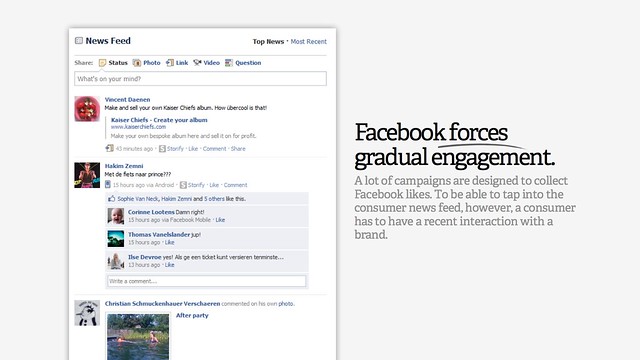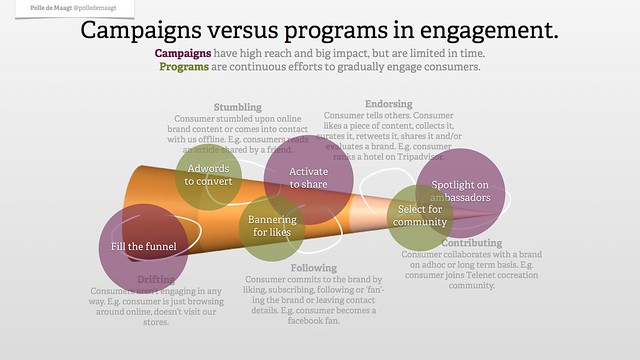Many recent brand efforts are designed to end up in user streams, whether on Facebook, Twitter or any other social network. Campaigns should be ‘worth sharing’, ‘conversation worthy’ or ‘retweetable’. Aim is to being conversation worthy on every brand level, so that people will talk about you, whether it is offline or online.
Often these ‘conversation-worthy’ ambitions are translated into short term social media campaigns. Success is measured in views, clicks and likes. In effect, the reach of Facebook social media campaigns and “success” is often guestimated by counting the number of people that shared a campaign elements, multiplied by the average number of Facebook friends (e.g. 2000 likes times 130 friends is a campaign reach of 260.000). That means that campaigns are deliberately designed to collect likes and shares. In result, some digital agencies and brands do the weirdest things to have a high number of likes: people who like a brand page are offered a bag, people are promised non-exisiting ‘fan’-only content and can win pretty much everything by liking, retweeting, sharing or subscribing.
This is an extremely short term effect. As my old friend Merlijn van Vliet puts it “Brands who are new to Facebook often get things the wrong way round. They want to be liked first before they share what they have to offer. For example, how many fan pages have you seen with big arrows pointing to the ‘Like’ button? Its as if these newcomers think that they have to explain to experienced Facebook how to use the ‘Like’ button…
This is usually an objective for marketeers who have not yet learned how to measure the success of this ‘new’ medium. Either that, or they want to build up a critical mass first and put off creating a bond with their ‘fans’ until later.”.
But it isn’t merely about managing expectations and disappointing consumers by offering no compelling content and no bonding. A key reason is the importance of gradual engagement.
Actual reach: the stuff that REALLY ends up in the consumer newsfeed
First, what types of content end up in the news feed? Facebook says “News Feed — the center column of your home page — is a constantly updating list of stories from people and Pages that you follow on Facebook. The News Feed algorithm bases this on a few factors: how many friends are commenting on a certain piece of content, who posted the content, and what type of content it is (e.g. photo, video, or status update)“.
So exactly what decides what’s interesting? This is pretty much a black box. Chance is you’ve worked extremely hard to acquire fans to like your page and now they’re most likely never going to see you updates. Facebook’s thought makes sense: to encourage users to interact with more and grow closer to the people they already have a history of interacting with. Weaker social connections (like with brand Pages) are less prioritized in this view.
In other words: a campaign that collected 100.000 likes at some point didn’t actually collect 100.000 likes. Every day a brand page doesn’t engage with it’s likers, the reach declines because the brand page updates. The longer a user doesnt interact with a brand on Facebook, the less wall posts, video’s and photos end up in the user newsfeed.That means:
- It is really important to post relevant content that triggers user interactions.
- It is better to invest less in acquiring likes and more in relevant small interactions that keep people engaged, to be able to maintain reach and have a relevant long-term presence.
Gradual engagement
Hence, the importance of gradual engagement, small mini campaigns that create a continuous stream of small interactions. The more a brand is able to keep a user engaged, the more the actual reach is.
That means Skittles’ Facebook presence might be even more brilliant than you have thought. They use small copylines and images to trigger likes and comments.
That means KLM‘s action where they asked users to comment on the picture of a whiteboard to actually write all that names on the same whiteboard later that day was really smart.
That means that besides planning for campaigns (and reach), brands should start planning for long term reach through gradual engagement. Not only to be relevant and to stay interesting. But most importantly, to actually maintain an audience.


